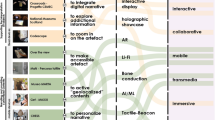Abstract
Human-harmonized information technology is intended to establish basic technologies to achieve harmony between human beings and the information environment by integrating element technologies encompassing real-space communication, human interface, and media processing. It promotes a transdisciplinary approach featuring (1) the recognition and comprehension of human behaviors and real-space contexts by utilizing sensor networks and ubiquitous computing, (2) technologies for facilitating man–machine communication utilizing robots and ubiquitous networks, and (3) content technologies for analyzing, mining, integrating, and structuring multimedia data including those in text, voice, music, and images. It ranges from scientific research on the cognitive aspects of human-harmonized information processes to social implementations that may lead to breakthroughs in the harmonious interactions of human and information environments. In this chapter, I give an overview of achievements over the past eight years, remarking on insights as well as limitations. I also discuss future perspectives, singling out promising approaches.
Access this chapter
Tax calculation will be finalised at checkout
Purchases are for personal use only
Similar content being viewed by others
Notes
- 1.
- 2.
- 3.
- 4.
The sense of presence. It is present when its presence is recognized by a person. In contrast, an accompanying concept, sonzai refers to an objective presence.
- 5.
- 6.
- 7.
- 8.
- 9.
- 10.
- 11.
p. 124 in [25].
References
K. Aizawa, FoodLog: multimedia food recording tools for diverse applications (2016). (in volume 1)
M. Anderson, S.L. Anderson (eds.), Machine Ethics (Cambridge University Press, Cambridge, 2011)
Future of life institute. Autonomous weapons: an open letter from AI and robotics researchers (2015), http://futureoflife.org/open-letter-autonomous-weapons/
Future of life institute. Research priorities for robust and beneficial artificial intelligence (2015), http://futureoflife.org/ai-open-letter/
M. Goto, Building a similarity-aware information environment for a content-symbiotic society (2016). (in this volume)
K. Hiraki, Pedagogical machine: Developmental cognitive science approach to create teaching/teachable machines (2016). (in this volume)
S. Ise, Deelopment of a sound field sharing system for creating and exchanging music (2016). (in this volume)
H. Ishiguro, Transmitting human presence through portable teleoperated androids—a minimal design approach (2016). (in volume 1)
M. Ishikawa, I. Ishii, Y. Sakaguchi, M. Shimojo, H. Shinoda, H. Yamamoto, T. Komuro, H. Oku, Y. Nakajima, Y. Watanabe, Dynamic information space based on high-speed sensor technology (2016). (in volume 1)
T. Kanda, Enabling a mobile social robot to adapt to a public space in a city (2016). (in this volume)
M. Kashino, S. Shimojo, K. Watanabe, Critical roles of implicit interpersonal information in communication (2016). (in volume 1)
T. Kawahara, Smart posterboard: multi-modal sensing and analysis of poster conversations (2016). (in volume 1)
K. Kise, Reading-life log as a new paradigm of utilizing character and document media (2016). (in this volume)
Y. Koike, Elucidation of perceptual illusion and development of sense-centered human interface (2016). (in Volume 1)
J.H. Moor, The nature, importance, and difficulty of machine ethics, in Machine Ethics, ed. by M. Anderson, S.L. Anderson (Cambridge University Press, New York, 2011), pp. 13–20. Cambridge Books Online
T. Naemura, Inter-personal displays: augmenting the physical world where people get together (2016). (in this volume)
D. Pamlin, S. Armstrong, Global challenges: 12 risks that threaten human civilization (Global Challenges Foundation, Stockholm, 2015)
S. Russell, D. Dewey, M. Tegmark, Research priorities for robust and beneficial artificial intelligence. AI Mag. 36(4), 105–114 (2014)
Y. Sato, Y. Sugano, A. Sugimoto, Y. Kuno, H. Koike, Sensing and controlling human gaze in daily living space for human-harmonized information environments (2016). (in volume 1)
P. Stone, R. Brooks, E. Brynjolfsson, R. Calo, O. Etzioni, G. Hager, J. Hirschberg, S. Kalyanakrishnan, E. Kamar, S. Kraus, K. Leyton-Brown, D. Parkes, W, Press, A. Saxenian, J. Shah, M. Tambe, A. Teller, Artificial intelligence and life in 2030, 2016. One hundred year study on artificial intelligence: report of the 2015-2016 Study Panel (Stanford University, Stanford, CA, September 2016), http://ai100.stanford.edu/2016-report. Accessed 1 Aug 2016
S. Tachi, Haptic Media: construction and utilization of haptic virtual reality and haptic telexistence (2016). (in volume 1)
K. Takeda, Modeling and detecting exceesive trust from behavior signals: Overview of research project and results (2016). (in volume 1)
K. Tokuda, User generated dialogue systems: uDialogue (2016). (in this volume)
D.R. Traum, Do’s and don’ts for software companions. In Proceedings of the International Workshop on Emotion Representations and Modelling for Companion Technologies, ERM4CT ’15 (ACM, New York, NY, USA, 2015), pp. 3–3
S. Turkle, Alone Together: Why we expect more from technology and less from each other (Basic Books, New York, 2011)
Y. Yagi, Behavior understanding based on intention-gait model (2016). (in this volume)
Author information
Authors and Affiliations
Corresponding author
Editor information
Editors and Affiliations
Rights and permissions
Copyright information
© 2017 Springer Japan KK
About this chapter
Cite this chapter
Nishida, T. (2017). Epilog. In: Nishida, T. (eds) Human-Harmonized Information Technology, Volume 2. Springer, Tokyo. https://doi.org/10.1007/978-4-431-56535-2_9
Download citation
DOI: https://doi.org/10.1007/978-4-431-56535-2_9
Published:
Publisher Name: Springer, Tokyo
Print ISBN: 978-4-431-56533-8
Online ISBN: 978-4-431-56535-2
eBook Packages: Computer ScienceComputer Science (R0)





